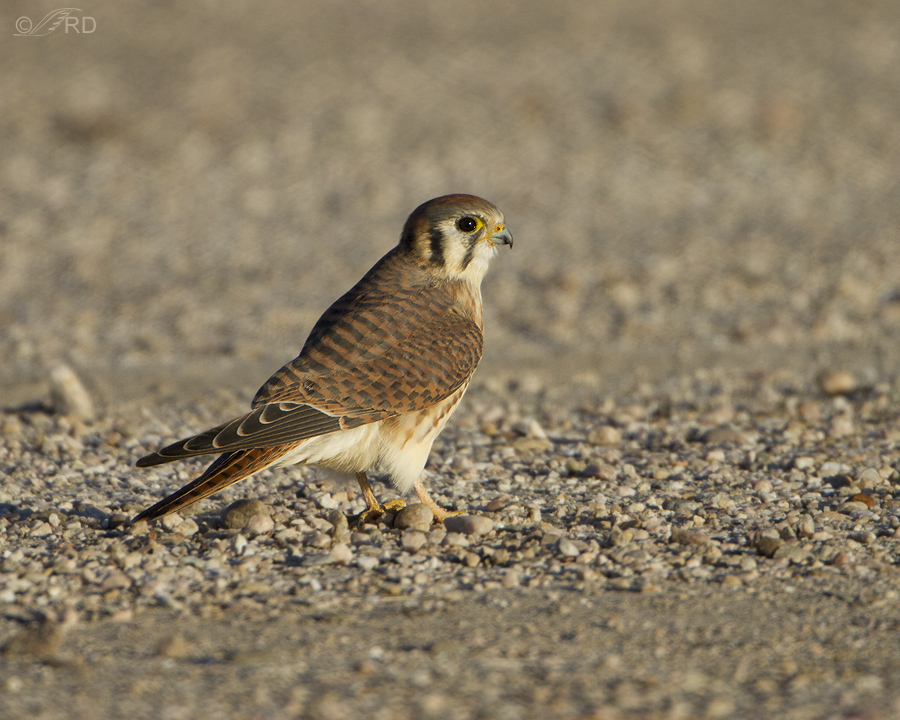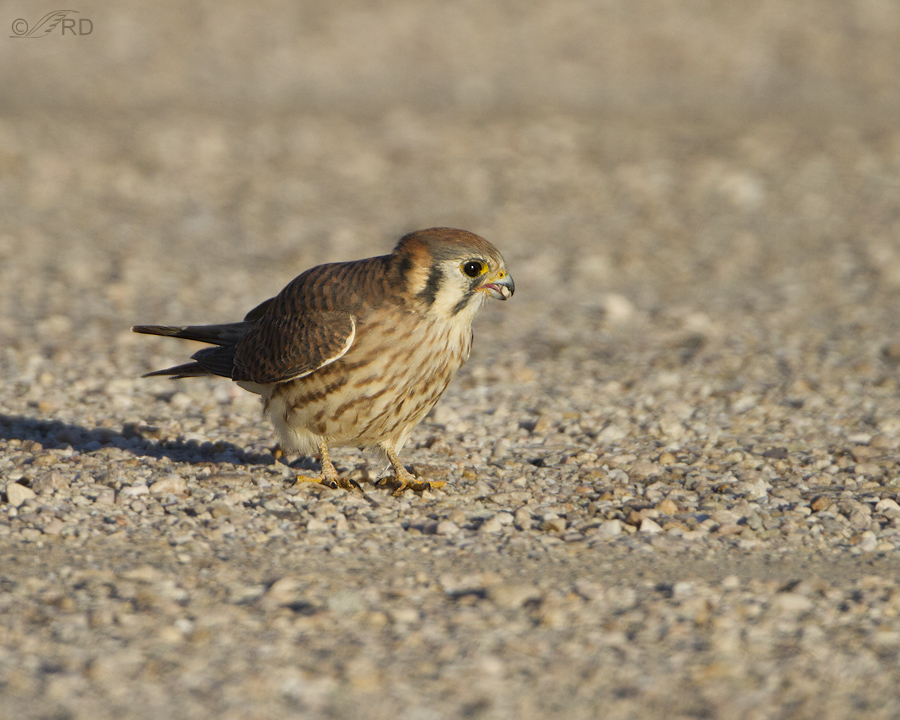I don’t have any beautiful photos today but I do have some interesting behavior.
Yesterday morning, I came across this female American Kestrel sitting in the middle of a large, isolated, gravel parking lot/camping area on Antelope Island. I thought it was an unusual resting place for a kestrel and as I approached her in my pickup I was even more intrigued when she didn’t immediately fly off, as this species typically does.

She repeatedly took a couple of wingbeats and flew a few feet, but never far. She was, for some reason, reluctant to leave and at first I couldn’t figure out why.

I was eventually able to work my way close enough to her to see that she was swallowing small stones from the gravel parking lot.

This was a behavior that I’d never seen before in a raptor, though I’ve often seen it in other birds. As a biologist, I’m aware of the general function of the gizzard in birds – that seed eating birds swallow “grit” to act as teeth (birds have no true teeth, presumably a weight saving adaptation for flight) within the grinding gizzard so they can physically break down their hard food and prepare it for chemical digestion. And it had been my understanding that raptors don’t consume grit because they don’t eat seeds. The flesh they consume is easily digested and doesn’t need to be physically broken down first.
So why is this little falcon swallowing small stones? I decided to ask Mark Runnels, an extremely knowledgeable master falconer from Oklahoma and an all around nice guy. I’ll try to summarize his detailed response below.
Hawks, falcons and eagles do not eat grit or small stones to digest their food like most other birds do. The flesh they consume is turned to liquid in the crop by strong acids and indigestible materials (teeth, fur, feathers etc) are regurgitated as pellets. So grit is not needed by these birds as a digestive aid.
But these raptors still consume stones and there’s a very good reason why. The diet of these birds (plump rodents, grasshoppers etc) is very fatty and eventually a thick layer of greasy fat builds up in the lining of the crop, which becomes a hindrance to the proper functioning of that organ. So they swallow small stones, which scour out the greasy lining of the crop and eventually they will be cast out, just like pellets. And when they are, they’re covered in heavy grease.
Mark goes on to say that old-time falconers used to gently force small stones (called “rangle”) into their falconry birds until their crops were about half full. The indigestible stones were later cast out, covered with a heavy layer of grease (called “gleam”). Modern falconers have mostly abandoned this practice and focus on “whole body nutrition”, where the bird is allowed to eat food with lots of casting material (bones, feathers, etc) which, when cast out, carries with it much of the fat from within the crop. Falconers also occasionally provide their captive birds with small, smooth, round stones.
Anyway, I find this kind of stuff fascinating and hope at least a few of you share that interest.
And thank you, Mark Runnels. Once again!


I know I use this word a lot, but this is fascinating. I always look forward to your posts. Thanks for sharing with those of us who are “stuck” behind a desk in an office but wish we weren’t.
Hey Ron, we wrapped up our fall migration count yesterday. It’s too early to extract any conclusions, but it was generally felt that Kestrel numbers were significantly lower. I hope it’s due to them being too weighted down to fly south…
I’m sorry to hear that Mike. I’d hoped they’d had a good breeding season. We saw significantly larger numbers of juveniles than usual in SW Montana this summer.
Fascinating! I’ll have to watch for this behavior, but I’ve never seen it.
It was a new behavior for me too, Scott.
Ron:
Interesting and informative post with great photos.
Dave
Thanks, Dave.
How fascinating. I am always on the look out for more information to add to the rag bag in my head. And I loved this, and your photos of the bird in question. A big thank you to both you and to Mark Runnels.
Thank you for the positive feedback, Tana and Sharon.
Wonderful info, Ron. Thanks for sharing it with us!
Fascinating!
Hi Ron,

Wow. That seems to be the first word in most of my replies to your posts. I really enjoy animal behavior, and this is fascinating stuff. Now I’ll be ready when it shows up as a Jeopardy topic!
I have told you in the past that I am a continuing student of birds and birding. Thank you for continuing to be one of my teachers. Cheers, Dick
I think we’re all teaching each other here, Dick. I’m learning a lot too.
Very informative, Ron. And I do think your photos are beautiful.
A side note, I ran into a falconer today, Bob Lauer. He wants me to do some photos for him when I return from my trip. He says he owns a Harris Hawk. He also said that he was the only falconer in this area.
Thanks, Bob. In my recent research on the subject I discovered that there are very few falconers in this country – largely due the the strict regulations and huge financial and time demands the “sport” requires. I suspect that is why your new friend is the only falconer in your area. Have a great time at Big Bend NP!
Absolutely FASCINATING… I had no idea. Thanks so much for the lovely images and lesson!!
I’m glad you enjoyed the post, Christina.
Thank you. I volunteer with wild raptors so of ourselves know about pellets. With your permission I would like to copy this and take it to where I work. We feed our animals lab mice and rats mixec with some purchased prey food. When I “prepare” it it does not look or feel greasy but I think this should be known. Again thanks for all you show us
Permission granted, Diana. And thank you for what you do with the raptors.
Hi Ron, one small correction. Grit implies small rough sand and stones that are eaten by seed eating birds. Every example I have ever seen of a falcon eating stones have been smooth round stones that are a little larger than a pea. As a general rule, we avoid any type of sand or grit in the bird’s living area (don’t want to take a chance on rubbing a sore if the sand gets under her jesses), but we do make sure that they occasionly have access to smooth river gravel if they want it.
Thanks for the great work you do. I love the pictures of the birds.
Mark
Thanks, Mark. I’ve made the corrections in the post. Let me know if I still messed up on something. When I’m “speaking” for someone else, I want to get it right.
Very interesting! Thanks for being a bird behavior detective.
That’s a name I’ve never been called before, Teri but it’s a moniker I like. Thanks